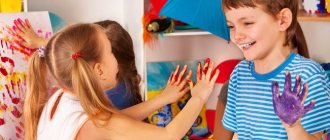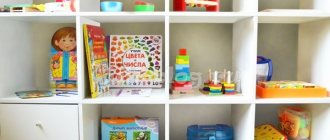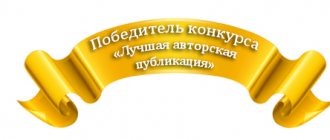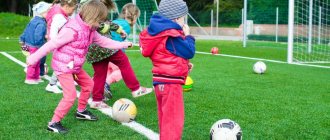Developmental activities for children 3 - 4 years old “The world around us”
Author I. Bushmeleva. Artist N. Gubareva.
At the age of 3-4 years, a child should be able to determine the time of day without difficulty.
Task for a child : Look carefully at the picture and say what the artist mixed up, what he drew incorrectly, why?
A child aged 3-4 years usually already knows that different vehicles are driven by different people. Tell him the name of the professions “machinist”, “tanker”, so that these words will enrich your child’s vocabulary.
Task for the child: Pick a pair. What kind of transport does this or that driver drive?
The child must answer your questions. It is important to present everything in the form of a game.
Assignment (questions) for the child:
1. In the morning the sun rises, and in the evening... (sets)
2. It rained, and... (puddles) appeared on the asphalt
3. Birch has leaves, and pine has... (needles)
4. In winter it often snows white, fluffy... (snow)
5. Water flows from the tap. And when it freezes, it turns into... (ice)
6. Is the ice soft or hard? (solid). Can it flow like water? (No). Is it cold or warm? (cold). Is the water cold or warm? (can be cold and warm).
A 3.5-4 year old child must distinguish animals that can live in city apartments from animals living in the countryside.
Activity with a child: look carefully which of these animals live in the village.
We teach a child to recognize a tree by its leaves. We study the names of flowers.
Task for a child : look at the leaves, from which tree did they fall (birch, maple, willow)? What are these flowers called (chamomile, rose, tulip, cornflower)?
A child of 3-4 years old, of course, already knows wild animals (from fairy tales, pictures, poems). He must be able to describe the animal and tell some of its features.
Activity with a child : There are animals in the picture, name them. Which one of them lives, where does it live, what does it like to eat, what color is its skin, which one is bigger? What are the “legs” of a wolf (paws) called? What about the elephant's nose (trunk)? Which animal has the largest neck, ears, teeth?
A child of 3-4 years old should be able to separate vegetables from fruits and voice the fact that some fruits are vegetables (grow in the garden), and others are fruits (grow on trees).
Assignment for a child: Miraculously, the tree grew fruit. Name them. Look and tell me which fruits do not grow on trees. Where do they grow?
A child aged 3-4 years already knows that there are adults and children. But what are they called correctly?
Activity with a child : Please tell me who is drawn in this picture (animals, beasts)? Please note that these are parents and their children. Do you know what they are called? (elephant (elephant) - baby elephant, bear (shema bear) - bear cub, cat (cat) - kitten, tiger (tigress) - tiger cub).
A 3.5-4 year old child should already know polite words and be able to use them correctly.
Lesson with a child: question - answer. Ask your child to answer your questions.
- In the morning you woke up and went to brush your teeth, on the way you met your mother. What will you tell her? (Good morning).
- In kindergarten, the girl Tanya treated you to an apple, and you told her... (thank you).
- You have friends? What are their names? If your friend asks you to help him, what will you do? (I'll help).
- Do you go to kindergarten? What time of day do you come to kindergarten (in the morning), and when do your parents pick you up (in the evening).
- What do you say to your family when you go to bed (good night).
- You came to visit a friend, what will you say when you see him? (Hi Hello).
- Mom asked you to help her clean the room, what will you do? (I’ll help, collect toys, etc.).
- Grandma was knitting socks for you, and her ball of yarn fell, what will you do? (I'll pick it up).
Development of fine motor skills
It is very important not to miss this moment. Many parents who conduct activities and games for children 3-4 years old at home completely forget about motor skills. But in vain, because this skill is the strongest stimulus for the development of a child’s memory, thinking, speech and attention.
Great activities include:
- fastening, sorting (you can also use ordinary fasteners, buttons, buttons, eyelets);
- laying out drawings or patterns (from pebbles, cereals, shells);
- sandbox games;
- constructors, cubes;
- various lacings;
- finger games (various gestures are performed to the accompaniment of certain children's poems - clapping, clenching, unclenching fists, etc.).
Garden.
Your child will be incredibly happy and interested if you together organize his own small garden outside this summer. Even if you live in a high-rise building, you will definitely find a secluded place on the lawn near your house. Together with your baby, fence it off with pebbles or a small fence, clear it of vegetation, loosen the soil and water it.
And then do whatever you want: plant flowers, carrots, strawberries together... Or maybe you should plant a real beauty - grow a huge sunflower from a small seed?
Teach your child to look after your pets - weed weeds, water (in the morning or evening, explain what will happen if you water the garden in the middle of the day under the hot rays of the sun). Together, rejoice at the first shoots, admire the results of your work, and decorate the flowerbed with funny figures.
What does this give to the child?
Working in the garden for a child is his first biology lessons, a visual acquaintance with the life of plants. In addition, such manual labor develops motor skills, teaches responsibility, and simply makes you happy.
Fun math for a walk.
While walking on the street, you can play math games with your child:
— Mom draws small circles on the asphalt (flowers, boats, etc.). Then he asks the child to count how many circles are drawn. When the counting is done, mom draws the required number next to the circles (for example, three circles - draw the number 3).
— Mom draws a number on the asphalt and asks the child to put as many pebbles (flowers, twigs) next to it as the number represents (for example, next to the number 2 we put 2 flowers).
- Another simple and accessible way to teach counting while walking is to count various objects - steps, cars, pebbles, benches, trees, etc.
— While walking in the yard, play shopping with your child . You can sell and buy anything. And pebbles or leaves can serve as money. A spatula costs three rubles, which means we give mom three pebbles for it. And the bucket costs five - try to count out the required number of “coins”.
— We study “more and less.” We place three blades of grass and two pebbles in front of the child. Let the child answer which is more - pebbles or blades of grass.
— For this game you will need small animal figurines (for example, from a Kinder Surprise). A bunny, a bear and a squirrel found three “berries” in the garden (we place three pebbles in front of the child). Are there enough berries to feed all your friends? What if there are two “berries”?
One day one letter.
You can quite successfully teach your child letters on the street. There are a lot of games for learning letters outdoors. For example:
— Mom draws a letter on the asphalt with chalk and memorizes it with the child. Then asks him to name words that begin with this letter (on his own or with his mother’s prompts). When the child names a word, the mother draws a picture depicting this word (children love it when adults draw something for them, so drawing is a great way to attract the child’s attention to learning letters).
— Mom draws a lot of letters on the asphalt with chalk, among which will be the letter that the child learned today. The mother asks the baby to find the desired letter among all the letters and circle it (or cross it out). (“Look how many different letters! Find where the letter “K” is hidden!).
— Mom draws letters in chalk at a short distance from each other. Then he asks the child to jump over the letters as if over bumps. When jumping on each letter, the child must remember the word that begins with this letter (the mother can give hints at the same time) or simply remember the name of the letter together with the mother.
— the mother begins to draw a letter with chalk, stops somewhere in the middle, then hands the chalk to the child and asks him to finish drawing the letter.
- the mother draws a letter on the asphalt (so that it can be painted) and asks the child to color this letter with chalk.
- the oldest way of learning letters from our mothers and grandmothers - we study the letters on signs and plates that you see on the street.
Sensory
It makes me happy when I hit a point of interest and the child gets carried away for a long time and tries something. So recently I noticed her craving for construction, and we purchased a magnetic construction set. I spent the whole day building it and couldn’t tear it away.
Developmental activities with sensory materials are very useful from the age of 3 years. They influence fine motor skills and indirectly prepare for writing and mathematics, as well as geometry and creativity. I made several sets with my own hands.
Noise cylinders. I made sound bottles from packages from Imunele - I simply poured beans, buckwheat and semolina into them. It is better to take cereals of different sizes.
Mysterious bag. You need to put objects of different shapes or textures into an opaque bag. The older the child, the less different they should feel to the touch. To complicate the game, you can add a second bag with the same contents. Ask them to find the same objects with different hands.
Paired color cards. A game-exercise on knowledge of colors and all shades. It starts with three basic colors and gradually increases in complexity to seven shades of each color: from the brightest to the palest. I want to get cards from the paint store so I can line up the colors.
We also arrange the chocolate egg fixies according to height. Or while walking in the forest we look for thick and thin trunks.
We have 2 rooms in our apartment: a kitchen-living room and a bedroom. In the living room there is a separate children's bookcase and a shelf for books. I change the materials from time to time, so this is once a creativity zone, once a music and sensory zone, but a set for caring for plants and a jug of water are always in their place. Nearby there is a workplace consisting of a table with a chair and a shelf for books.
Development of speech, counting, reading
At this age, according to psychologists, it is already possible to introduce “educational” topics for classes. Children should be interested in playful forms. By properly planning a “lesson”, you can easily teach a child.
List of classes:
- learning letters;
- reading;
- studying numbers;
- counting objects;
- adding missing words to the poem;
- retelling stories, fairy tales;
- description of a picture, object;
- guessing riddles;
- learning songs, poems;
- listening to fairy tales.
Development of logic
As noted above, the baby is already quite smart. Various problems arouse his great interest. Prepare special material for these classes in advance.
Recommended topics:
- the concept of “one - many”;
- comparison “small object - large”;
- familiarization with the concepts of “top” and “bottom”;
- long short;
- classification of objects (for example, groups - birds, trees, vegetables);
- high Low;
- color spectrum.
For such activities, it is advisable to use prepared cards. As a rule, kids are happy to choose the “extra” one from a group of objects and love to look for changes in pictures. They like to find the right pairs.
Activities and games during summer walks for children 3 years old.
- Seal
Details Author: Nalivaykina Lyudmila Published May 27, 2016
Summer is coming - a time of long walks, gentle sunshine and fresh air. In the summer, staying at home is a real crime - you want to walk as much as possible and enjoy the summer days.
Summer is not a reason to stop working with children. You can also play educational games during a walk in the summer.
Here you will find a selection of educational games and summer activities that can be done outside. Let your motto be “one walk - one educational game” - this pace will not tire either mother or child, and this summer you will not only relax, but also teach your fidget something useful.
Interests of three-year-old children
The main feature of a three-year-old baby is his increasing independence, but this should not frighten parents. If earlier he needed the help of adults, at three years old the child tries to do everything on his own, and you should not interfere with him in this. If you start to take care of your son or daughter, most likely they will grow up to be weak and insecure people. Therefore, to the best of our ability, it is necessary to encourage such a desire for self-expression, and not to crush it with the authority of a senior.
In addition, you can look at this with different eyes - by occasionally checking what the precious child is doing, dad and mom can allow themselves to rest or go about their business. The main thing is to guide the child in the right direction, to captivate him with something interesting.
The life of a three-year-old child still follows a certain schedule, and this should be so that he feels comfortable. Based on the fact that walking takes about four hours, the child spends most of the day at home, where his main activity is games, through which he continues his cognitive activity.
Despite the fact that the three-year-old already confidently walks and even runs, he spends most of his time on the floor, where he can play role-playing games, cars, or do creative work. This is quite normal, and it is not at all necessary to force him to sit at the table or on the sofa in order for him to do his business there. It is important that he feels free, both physically and mentally.





